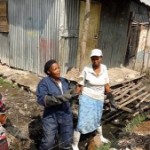SA Students: Slum Upgrade Fieldtrip
South African Cities Network. September 2012. The main theme of the Inclusive Cities programme revolves around whether residents have the opportunities and capacities to share equitably in the social benefits of city life. The programme objective is to enable cities to address the socio-economic challenges of South Africa’s segregated cities.
SA Students take filedtrip to Kenya to study comparative approaches to slum upgrade
“South African Cities Network contributed funding alongside the NRF and Wits University to support a group of Masters students’ fieldtrip to Nairobi, Kenya in September 2012.”
The group of 15 were students in the Wits Masters of the Built Environment in the field of Housing (MBE Housing) and some were in the MSc Development Planning taking housing electives. The selected students got to participate in various activities during the four-day trip to Nairobi:
Wednesday, 12-Sep-2012: Visits to Kibera settlement and Sanitary Facilities Project : Bio Center Innovations.
Thursday, 13-Sep-2012: Visits to Nachu (National Cooperative Housing Union) Office and UNHabitat.
Friday, 14-Sep-2012: Participation in “Re-Imagining Kenyan Urban Modernity: Symposium on the Slums Question in 21st Century,” a conference on slum upgrading & prevention policy hosted by the University of Nairobi and Pamoja Trust at the United Kenya Club.
Saturday, 15-Sep-2012: Visits to Mathare Valley and Kambi Moto in Huruma.
In addition to the invaluable learning experiences of the fieldtrips, the participating students had the opportunity to present papers at the symposium alongside Kenyan academics, practitioners and civil society activists. They are now being expected to develop these papers further into publications.
Pedagogically, a visit to Nairobi seemed relevant from several perspectives. Nairobi, as the host of UN-Habitat, has been at the centre of third world housing debates in the literature since the 1980s.
Its government, similarly to that of South Africa, is developing ‘slum’ upgrading policy and gradually moving into implementation, while also striving for world class city infrastructure and facilities.
A robust debate exists on the relevance of different approaches to housing and informal settlement upgrading and the challenges in managing existing low income housing stock.
A first-hand experience of the ‘slum’ and housing environments and of the policy debates is an invaluable experience that will place this group of students in a better position to navigate the difficult world of housing/human settlements policy development in the countries in which they pursue their professional careers.
The fieldtrip was led by Professor Marie Huchzermeyer of the School of Architecture and Planning at the University of the Witwatersrand, and associated with the university’s longstanding working relationship with the University of Nairobi’s School of Architecture, Design and Development.
The following field-trip reports were produced:
Perspective on Stormwater Drainage Issues in low-income human settlements – By Olumuyiwa B. Adegun
Perspective on Diverging Approaches to Slum Upgrading – By Lene Le Roux
Perspective on Non-conventional Management Practices between Landlords and Tenants – By Josephine Peace Enninful
Slum upgrading initiatives and their impacts on livelihoods – By Pumla Bafo
Report on Conference on slum upgrading & prevention policy – By Laura Burocco
Report on Visits to Mathare Valley & Kambi Moto in Huruma – By Laura Burocco
Report on Nachu Office and UNHabitat Office – By Laura Burocco
Annie Kelly – Bangladesh’s Urbanisation Creating a Healthcare Black Hole
 The Guardian. September, 18, 2012.
The Guardian. September, 18, 2012.
In 1901, the total population of the Bangladeshi areas of British India was less than 2%. Now, more than a century later, urban planners are predicting the country’s future will be one of sprawling, interconnected metropolises with a largely urban population moving between hundreds of cities and large towns.
Last year, the national census showed that out of a population of more than 150 million, just under 30% live in the rapidly expanding cities and towns, with the urban population increasing about 6% a year as millions of people leave rural areas in search of work.
Read more: Bangladesh’s Urbanisation Creating a Healthcare Black Hole
Clinton O. Aigbavboa and Prof. Wellington D. Thwala – Housing Experience of South African Low-Income Beneficiaries
Clinton O. Aigbavboa., PhD Candidate and Prof. Wellington D. Thwala., PhD., Eng. – University of Johannesburg – Johannesburg, Gauteng, South Africa.
Since the inception of the South Africa Government Housing Subsidy Scheme to solve the countries housing problem for the disadvantaged and low income groups, there is limited information available to ascertain the beneficiaries experience since they have been living in the subsidized housing units. This paper presents an evaluation of the post occupancy experience of Housing Subsidy beneficiaries in the Gauteng province of South Africa. It is an evaluation of the occupant’s experience since the inception of the policy to date, which is born out of the lack of POE monitoring. The paper present finding on the Socio- economic/demographic profile of the occupants since the housing units were allocated to them. Also, an evaluation of the right to housing is done, to ascertain if the right to housing as contained in the South Africa Constitution is being realized through the subsidized housing units. Others includes the level of beneficiaries’ satisfaction/dissatisfaction, beneficiaries’ home usage and the effect of the housing subsidy scheme on the present demand of housing in the country, since the government has approved housing subsidies for 3.1 million households and constructed over one and a half million housing units. Read more
Ilse Roodnat – Social Housing South Africa: A Research On The Niche Area Sunnyside, Pretoria.
HBO-Kennisbank, 2007 – The housing problems in South Africa are immense. The country copes with a huge housing backlog, especially in the urban areas in the low-income sector. Because of the apartheid spatial planning, where black people were not allowed to live in cities, the structure of South African cities and the area around it have developed a complex spatial structure which is difficult to break through. When the Apartheid era ended groups of oppressed black people started moving into the cities. This phenomenon was known under the white inhabitants of South Africa as the black threat, and in fear of a civil war the white inhabitants moved out of the cities. For a period of time the situation in the inner cities were critical without supervision, order and evacuated houses and offices crime evolved quikly and the degeneration of the inner cities was inevadable. The new democratic government of 1994 waited a tremendous task of stabilizing the environment to transform the extremely fragmented, complex and racially-based financial and institutional framework inherited from the previous government. By this means the new government focused on the quantity rather than the quality when it came to fighting the huge housing backlog. Over the next ten years the government delivered 1,6 million houses, building as much as possible as soon as possible resulted in more houses outside the cities far away from social and economic opportunities with great transportation difficulties. The new housing delivery did not deviate from the apartheid spatial planning; black townships predominantly stayed black with no possibility of racial integration, located far from economic activity, the low economic activity created extensive poverty, no recreational facilities resulting in deprived, depressed communities with nothing to do and no where to go.
Read more: http://www.hbo-kennisbank.nl/
Sriram Ramgopal – Slums in India
 The definition of “slum” varies from country to country. In India, each state has its own definition of slum. The National Definition of ‘Slum areas’ was set by the Slum Areas Improvement and Clearance act of 1956.1 It defines them as places where buildings:
The definition of “slum” varies from country to country. In India, each state has its own definition of slum. The National Definition of ‘Slum areas’ was set by the Slum Areas Improvement and Clearance act of 1956.1 It defines them as places where buildings:
– are in any respect unfit for human habitation;
– are by reason of dilapidation, overcrowding, faulty arrangement and design of such buildings, narrowness or faulty arrangement of streets, lack of ventilation, light, sanitation facilities or any combination of these factors which are detrimental to safety, health and morals.
The Census of India defines a slum as “a compact area of at least 300 in population or about 60-70 households of poorly built, congested tenements in an unhygienic environment usually with inadequate infrastructure and lacking proper sanitary and drinking water facilities.”
Read more Sriram Ramgopal – Slums in India
Claire Provost – UN Stresses Positives of Urban Growth with New Tool to Track City Prosperity
guardian.co.uk. September, 5, 2012. Cities should be seen as drivers of economic growth and human development, says report published at World Urban Forum. A new index to measure and track the prosperity of cities has been unveiled by UN-Habitat, the UN human settlements programme, in a bid to encourage a more upbeat view of the world’s rapid urbanisation.
Cities should be seen as drivers of economic growth and human development, according to the agency’s flagship State of the World’s Cities report, published on Wednesday at the sixth World Urban Forum (WUF) in Naples, Italy.
“A fresh future is taking shape, with urban areas around the world becoming not just the dominant form of habitat for humankind, but also the engine-rooms of human development as a whole,” said the report, which called on city planners, particularly in developing countries, to see urbanisation in a positive light. In 2010 the agency announced that, for the first time, more people live in cities than in rural areas.
“Cities have been perceived as the ‘engines’ of national economies and there is no reason to depart from that view,” said the report, pointing to numerous examples, from the US to Kenya, where urban areas contribute disproportionately to national wealth.
Read more: Claire Provost – Urban Growth Tool City Prosperity



